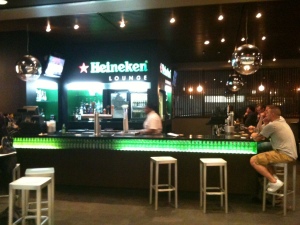Reading today about Apple redesigning their store experience got me thinking about the role of the store in the future. New online companies are exploding into multi-billion dollar vertical categories and growing rapidly. Does that mean there is no room for the store? Not in my mind, but it’s fundamental role will evolve consistent with our thesis around the convergence of offline and online models.
For the last few decades, retail companies expanded by driving greater and greater geographic footprint. Stores were the only point for transacting product and even today represent the preponderance of sales. “Same store” numbers helped to gauge the productivity of a store but top line most of the time was driven by number of new stores. Stores had P&Ls they were responsible for, and this system has created an entrenched infrastructure and KPI bias where many retailers measure and optimize around in-store traffic, rather than driving the “most efficient transaction” regardless of where they occur.
I believe this model has to change. Consumers have a myriad of choices on how and where to transact today. Online ordering with the very liberal return policies have made it far easier to buy something, try it, and send back than potentially taking a few hours to physically go somewhere. Buying has bifurcated into two buckets: routine transactions and inspired transactions. Routine transactions are things that we know we need, don’t require a lot of thinking, get replenished on a regular or reasonably regular basis, etc. We either know what we want (new jeans) or we’re indifferent across a broad enough range and need to solve a functional task (toothbrush). Inspired transactions are things that I’m not sure about, that I’d love to learn to fall in love with, that I am trying to discover. I want a new look instead of just jeans; I want to understand the philosophy of the brand that I am going to wear as I view it as an expression who I am.
I’d argue that the entire domain of routine transactions is designed to go online. It’s far more efficient and the best use of a consumers time. Educate me online and let me transact. Don’t make me spend hours to do a chore. The second category is where offline shines. I walk into the Apple store to engage with product. I’ll go into the Apple store to experience an iPad or the MacBook Air to see if I really care about how thin it is. I’ll subconsciously feel how “smart” the brand is in servicing me and differentiating. If I go to the showrooms on 5th Avenue, it’s to feel the luxury and curation of what Cartier or Saks represents. And it is about entertainment as much as anything else.
What does this all mean? Well, I see huge reductions in the number of points of presence for many retailers (not including same-day consumables like coffee or food). Retailers have to align with consumers, liberate their time and allow them to transact in whatever manner provides the greatest utility. Retailers should be in the business of selling things wherever that most efficiently occurs. My partner Larry told me about one innovative retailer that uses their physical store to crowd source and showcase new products only – as soon as something sells in meaningful volume (indicative of a repetitive buyer in a “routine transaction”), it is moved to the online store and that shelf space is freed for a new product to experience.
Over time, I see stores being “owned” by marketing and viewed as a brand expense instead of the revenue bearing, full P&L today. Should I penalize the store if you came in, had a great experience, and then bought online for convenience? Or more likely believe that it served its purpose? Controversial, maybe. But 10 years from now I think the retailers that survive the transition to digital will look at it more that way than how they do today. I also wouldn’t be surprised if 10 years from now, we see a flagship Gilt store on 5th Avenue and major cities around the world. It sounds crazy now, but that might be the most “efficient” way on a blended marketing basis to create mass awareness (like TV today).
The bottom line is that the role of the stores has to change. It cannot be about the purchase. Too much of buying is moving online. It has to be about experience, education, and inspired serendipity!

I think in dense urban environments in particular, it won’t make any sense to store inventory, but rather retail stores (particularly for things like consumer electronics, etc. in the short term) will become more like showrooms, simply acting as a marketing vehicle for online sale. Whether it becomes segmented by manufacturer (a Samsung store, a Sony store, etc.) or there is room for someone to aggregate it and still make enough margin is to be seen.
yes, agree…
exactly what I have been thinking for intuit and mint and i have a vision for stocktwits stores – genius bars for traders, investors with no transaction affiliation. just learning and buying data and classes as well as a club for the best traders in major cities.
Sounds like a fun place to pop into!
Terrific article! This is the type of information that are supposed to be shared across the net.
Shame on the search engines for no longer positioning this submit higher!
Come on over and talk over with my web site .
Thanks =)